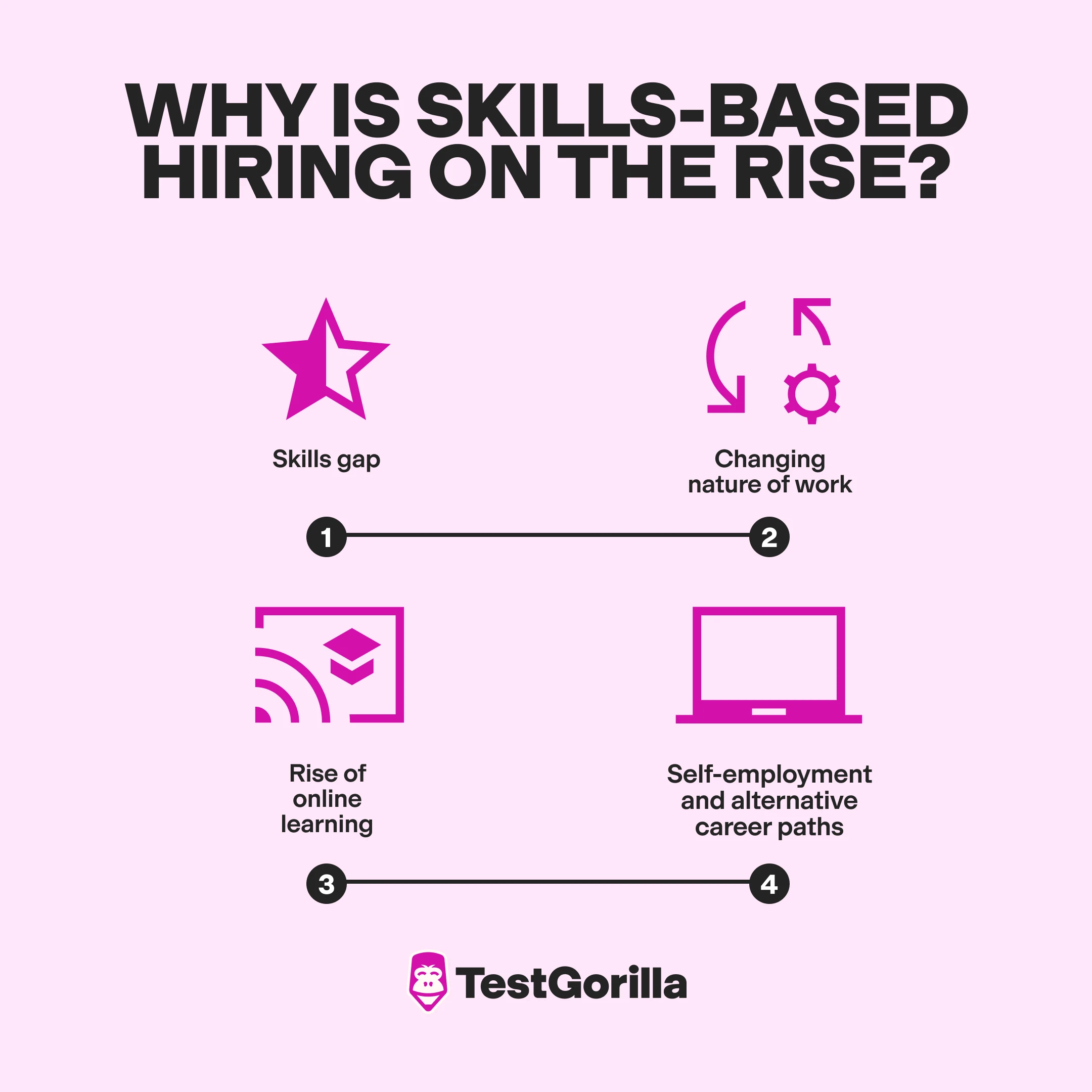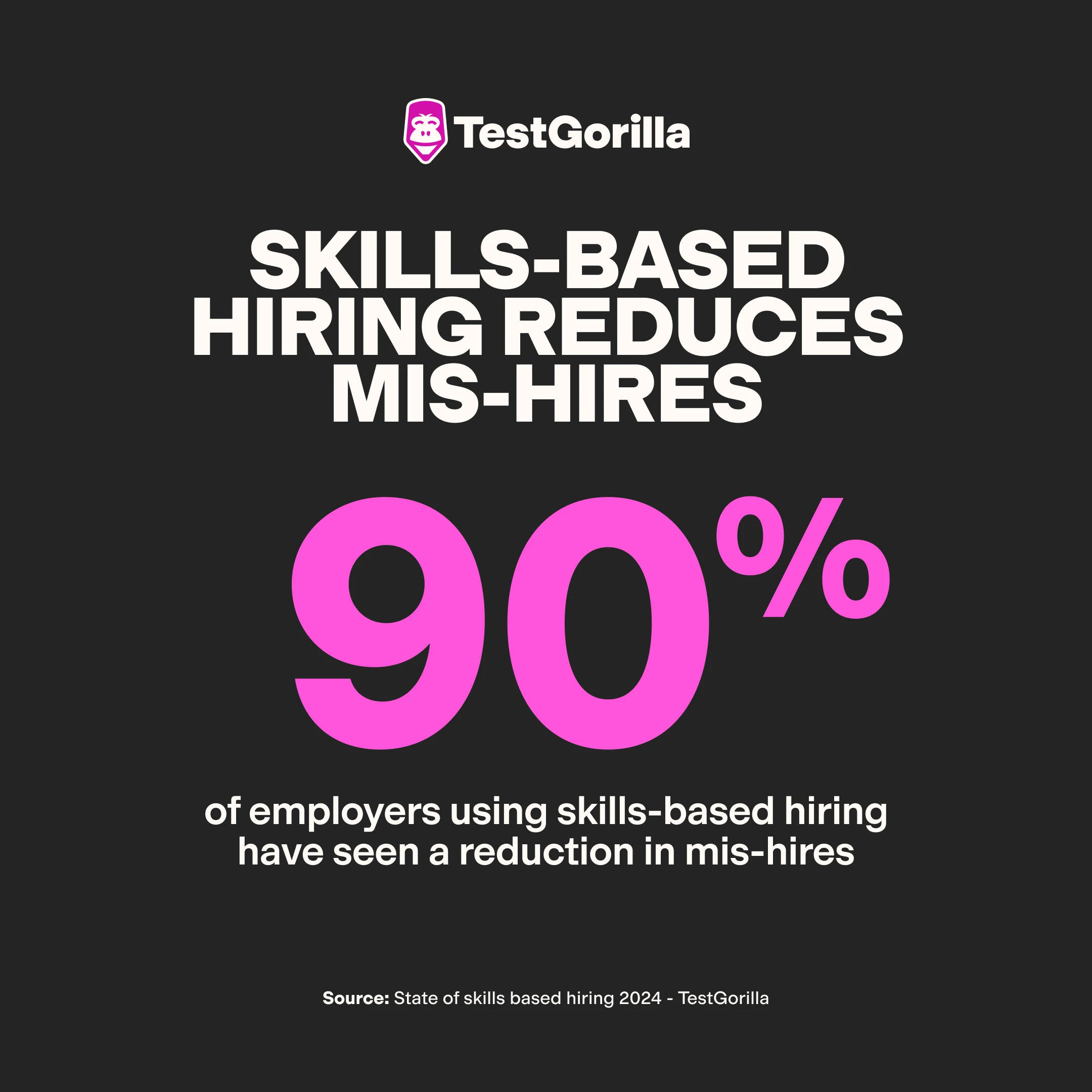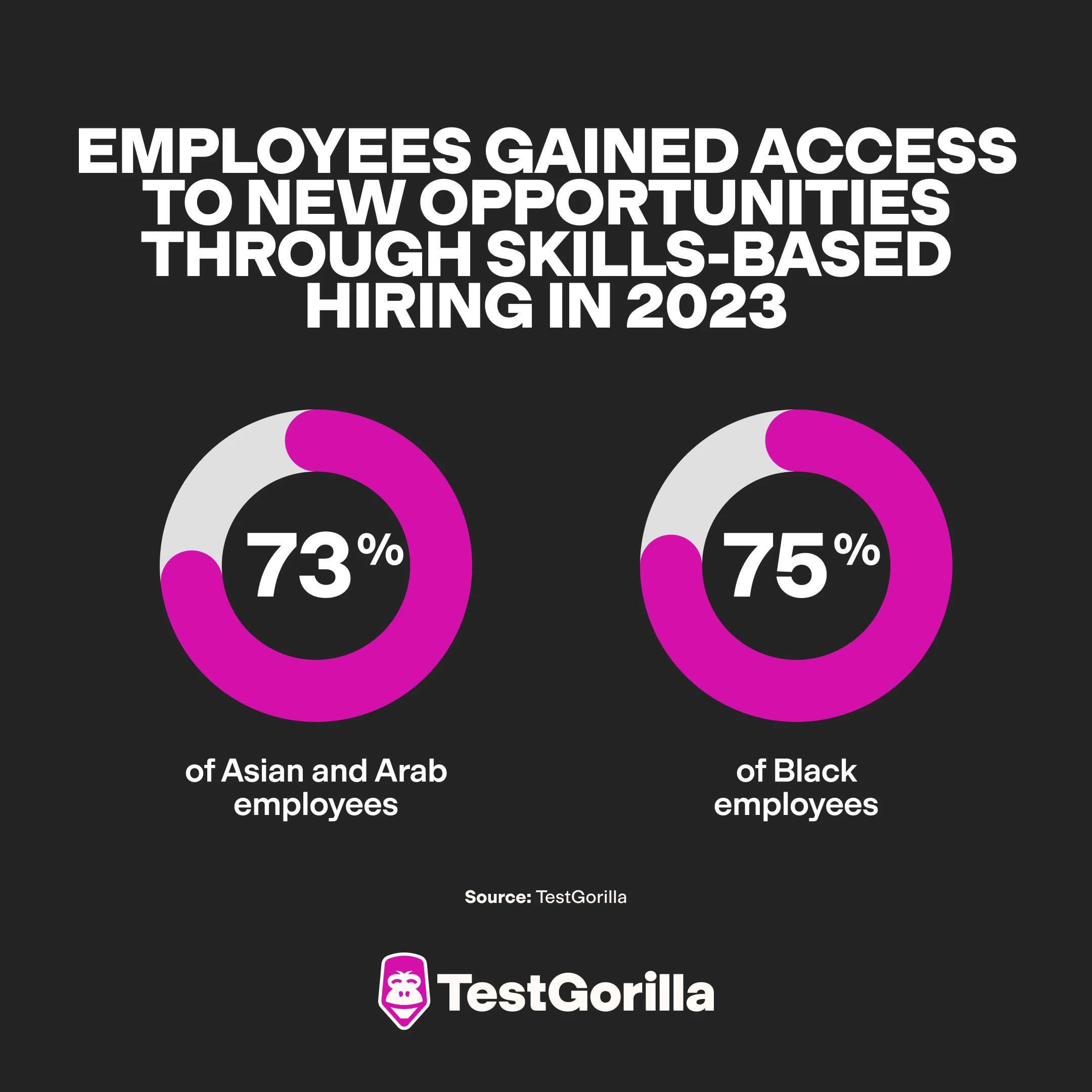51 key skills-based hiring statistics
If you’re interested in anything skills-based hiring-related – whether it’s rate of adoption, employee attitudes, or the benefits and impact of this hiring practice – then you’re in exactly the right place.
We collected responses from over 2,000 employers and employees to bring you The State of Skills-Based Hiring 2024; now, we’re bringing you 47 key skills-based hiring statistics.
Table of contents
Employers and skills-based hiring statistics
In 2024, the majority of employers have adopted some form of skills-based hiring. They perceive it as an effective hiring strategy, and they’re seeing measurable benefits. Here are 18 statistics on employer adoption, attitudes to, and benefits of skills-based hiring
Employer adoption of skills-based hiring
Globally, 81% of companies are using skills-based hiring in 2024.
This is compared to 73% in 2023 and 56% in 2022.
59% of those employers started using skills-based hiring in the last two years.
49% are using cognitive ability tests
49% are using role-specific tests
38% are using work sample assignments
42% are using preference tests
60% of companies expect their budget for skills-based hiring to increase in the next 12 months, and 35% say it will stay the same.
Employer attitudes to skills-based hiring
98% of employers believe skills-based hiring is more effective at identifying talented candidates than resumes
94% of employers believe that skills-based hiring is more predictive of on-the-job success than resumes
88% of employers believe that employees hired via skills-based hiring stay longer in their roles
56% said skills-based hiring helps them verify candidates' soft skills
54% said it helps them verify hard skills
53% said it helps them verify cognitive abilities
Benefits of skills-based hiring for employers
90% of employers using skills-based hiring reduced mis-hires
91% of employers using skills-based hiring boosted retention
81% of employers using skills-based hiring reduced their total time-to-hire
78% of employers using skills-based hiring reduced their total hiring costs
90% of employers using skills-based hiring improved workplace diversity
Skills-based hiring adoption rates statistics
Let’s dive a little deeper into the data on skills-based hiring adoption rates. Below are 10 statistics about skills-based hiring adoption rates divided by organization type, industry, and region.
By organization type
75% of remote organizations are using skills-based hiring, a decrease of 20% from last year
85% of hybrid organizations are using skills-based hiring, an increase of 21% from last year
70% of in-person organizations are using skills-based hiring, an increase of 13% from last year
Companies with between 501 and 1000 employees are using skills-based hiring the most in 2024 (88%)
By industry
The industries with the highest adoption rates of skills-based hiring are marketing (95%), scientific and technical services (89%), and construction (89%)
The industries with the lowest adoption rates are hotel and foods services (54%), wholesale (56%), and government and public institutions (61%)
By region
87% of US companies are using skills-based hiring, compared to 71% in 2023
80% of Canadian companies are using skills-based hiring, compared to 74% in 2023
84% of UK companies are using skills-based hiring, compared to 75% in 2023
94% of Latin American companies are using skills-based hiring, compared to 72% in 2023
91% of Australian companies are using skills-based hiring in 2024, compared to 90% in 2023
67% of French companies are using skills-based hiring in 2024
86% of Spanish companies are using skills-based hiring in 2024
Employees and skills-based hiring statistics
Employees are incredibly supportive of the adoption of skills-based hiring practices; they perceive significant benefits and want to see adoption increase. Read key stats below!
Employee attitudes to skills-based hiring
90% of candidates agree that they’re more likely to secure their dream job with skills-based hiring
81% of employees say they have gained access to new employment opportunities through skills-based hiring. This is compared to 66% in 2023.
68% of employees say they prefer hiring processes that include skills-based assessments. This is compared to 56% in 2023.
15% prefer a hiring process without skills-based assessments.
56% of employees would like to see the adoption of skills-based hiring increase in the next 12 months
84% of employees feel that skills-based assessments help to reduce unconscious and/or conscious bias during the hiring process. This is up from 69% last year.
85% of employees agree that skills-based assessments help them better understand the specific job requirements of a role.
Of the 15% who prefer a hiring process that doesn't include skills-based assessments, 57% say it's because it makes them anxious, and 52% say it's because they end up taking tests that aren't relevant.
Skills-based hiring and diversity statistics
Diversity is an objective for the majority of employers and employees. Here are 5 statistics for skills-based hiring and diversity.
85% of employers report that diversity is an objective for them in 2024 (no change from 2023).
90% of employers using skills-based hiring reported an improvement in diversity, with 23% reporting a very large improvement
31% of employees say they have experienced and been negatively impacted by conscious and unconscious bias during the hiring process (an increase from 21% in 2023)
75% of Black employees gained access to employment opportunities through skills-based hiring in 2023
73% of Asian and Arab employees gained access to employment opportunities through skills-based hiring in 2023
The future of skills-based hiring statistics
60% of employers expect their budget for skills-based hiring to increase over the next 12 months. 35% say it will stay the same.
Only 5% of employers expect their skills-based hiring budget will decrease
58% of employers say they will use skills-based hiring more than they did in the last 12 months
Only 8% of employers say they will use skills-based hiring less often
68% of employees want to see the adoption of skills-based hiring methods increase in the next 12 months. This is up from 42% in 2023.
Only 7% of employees want to see skills-based hiring adoption decrease
For the rest of the story, read our report
So there you have it – all the skills-based hiring statistics you could possibly need. In case you do need more, check out our State of Skills-Based Hiring report for the rest of the skills-based hiring story. Alternatively, check out 17 essential resume statistics.
Related posts
You've scrolled this far
Why not try TestGorilla for free, and see what happens when you put skills first.
Latest posts
The best advice on pre-employment testing, in your inbox.
No spam. Unsubscribe at any time.

Hire the best. No bias. No stress.
Our screening tests identify the best candidates and make your hiring decisions faster, easier, and bias-free.
Free resources
This checklist covers key features you should look for when choosing a skills testing platform
This resource will help you develop an onboarding checklist for new hires.
How to assess your candidates' attention to detail.
Learn how to get human resources certified through HRCI or SHRM.
Learn how you can improve the level of talent at your company.
Learn how CapitalT reduced hiring bias with online skills assessments.
Learn how to make the resume process more efficient and more effective.
Improve your hiring strategy with these 7 critical recruitment metrics.
Learn how Sukhi decreased time spent reviewing resumes by 83%!
Hire more efficiently with these hacks that 99% of recruiters aren't using.
Make a business case for diversity and inclusion initiatives with this data.




















